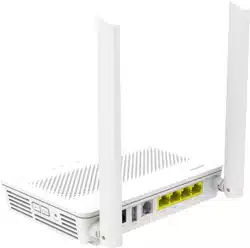Loading ...
Loading ...
Loading ...

1/13/2020 HedEx Startpage
localhost:7890/printtopics.html?time=Mon Jan 13 2020 13:54:48 GMT+0100 (Central European Standard Time) 69/86
Parameter Description
Digitmap Long Timer Indicates the long timer of the digitmap. This timer starts up if the dialed digits comply with the dialing scheme but one more digit is
required.
Shared User Mode Specifies whether to bind telephone numbers to phone ports.
Disabled: The shared user mode is disabled.
Parallel ringing: If this option is selected, only one telephone number can be configured. That is, all phone ports on the ONT
share a telephone number. All telephones ring together when an incoming call is made. If two telephone numbers are
configured, this option is invalid.
Multihoming Mode The multi-homing mode supports multiple IP addresses for one end point. That is, one end point can use multiple physical network
ports. This improves the end point reliability. If this mode is enabled, two servers (active/standby) must be configured.
Disabled: The multi-homing mode is disabled.
Dual homing (not automatic switchback): Once an ONT is registered with a softswitch (no matter active or standby), the
softswitch is always used as long as it works correctly.
Dual homing (automatic switchback): The ONT switches back to the active softswitch when detecting that the active
softswitch recovers and is reachable.
Loading sharing: The ONT is registered with one of the addresses resolved from the domain name to ensure that multiple
softswitches process services in load sharing mode.
DTMF Transmission
Mode
Specifies the DTMF signal transmission mode. DTMF signals can be transmitted transparently or in RFC2833 packets.
RFC2833 Payload Type Specifies the payload value used for transmit DTMF signals in RFC2833 packets. It ranges from 96 to 127.
Voice Server Type Indicates the supported voice server type.
IMS SIP Server: core network service type based on the SIP protocol.
Softswitch: softswitch NGN service type based on the SIP protocol.
H.248 Server: H.248 service type.
Offhook DT-AS ACK
Interval
Indicates the time during which the DT-AS signal (detects whether a phone supports offhook CLIP) waits for a response from the phone.
Advanced User Parameters(SIP)
Codec Indicates encoding/decoding. In encoding, the DSP encodes TDM voice data into packets and sends the packets to the IP network. In
decoding, the DSP decodes the voice packets received from the network and sends the data to the TDM side. Four types of codec are
supported: G.711MuLaw, G.711ALaw, G.729, and G.722; and supports silence compression.
Packet Time Indicates the interval at which the DSP assembles voice packets. Different encoding modes support different packetization periods. The
period can be 10 ms, 20 ms, or 30 ms, and the default period is 20 ms.
Priority Indicates the codec priority. Two users negotiate the priority in descending order. Currently, priorities 1-4 are supported, with 1 being the
highest priority.
Enabled Indicates whether the user carries the codec (enable: carry; disable: not carry).
DSP TX Gain Indicates the direction in which gain takes effect: from the local POTS side to the remote IP side.
DSP RX Gain Indicates the direction in which gain takes effect: from the remote IP side to the local POTS side.
Enabled HotLine Enables or disables the hotline function.
HotLine Number Indicates the hotline number. After the user specifies a number as the hotline number and also enables the hotline function, the number is
automatically dialed if the user does not dial the number following a delay time expiration after offhook.
HotLine Delay Indicates the period over which the user does not dial the number after offhook.
Enable Call Forwarding
Unconditional
Enables the call forwarding unconditional (CFU) function. A called party-side service, with which, a user can unconditionally forward
all incoming calls to a designated forwarded-to number or a voice mailbox.
Call Forwarding
Unconditional Number
Indicates the forwarded-to number.
Enable Call Forwarding
Busy
Enables the call forwarding busy (CFB) function. A called party-side service, with which, a user can forward all incoming calls to a
designated forwarded-to number or a voice mailbox when the user is busy on another call.
Call Forwarding Busy
Number
Indicates the forwarded-to number.
Enable Call Forwarding
on No Reply
Enables the call forwarding on no reply (CFNR) function. A called party-side service, with which, a user can forward all incoming calls
to a designated forwarded-to number or a voice mailbox if the calls are not answered within a preset period.
Call Forwarding on No
Reply Number
Indicates the forwarded-to number.
Call Waiting A called party-side service, with which, if user C calls user A when user A is talking with user B, user A hears a call waiting (CW) tone
indicating that there is an incoming call.
Message Waiting
Indicator
This indicator on the phone is on when receiving a new message for a user who is provisioned with the voice mailbox service.
Three-party Call When user A is communicating with user B and user C wants to join the call, user A can call user C without disconnecting the call with
user B. In this case, these 3 users can communicate with each other or two of three can communicate with each other.
Call Holding A user in a call can hold this call.
Malicious Call
Identification
A called party-side service, with which, a user can identify the calling number if the user receives a malicious call.
Loading ...
Loading ...
Loading ...
